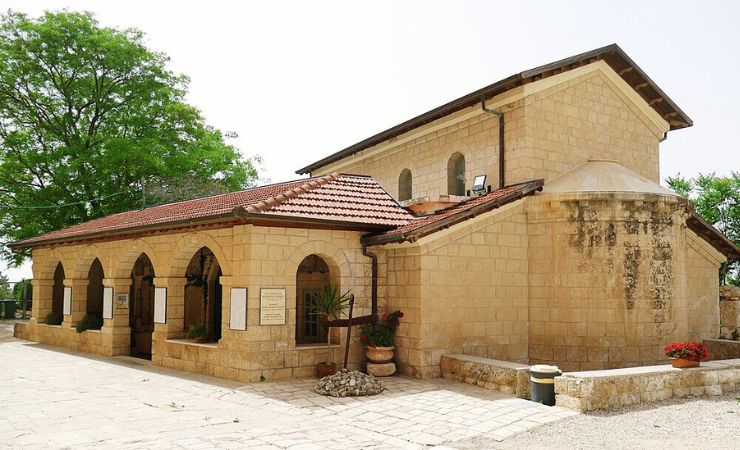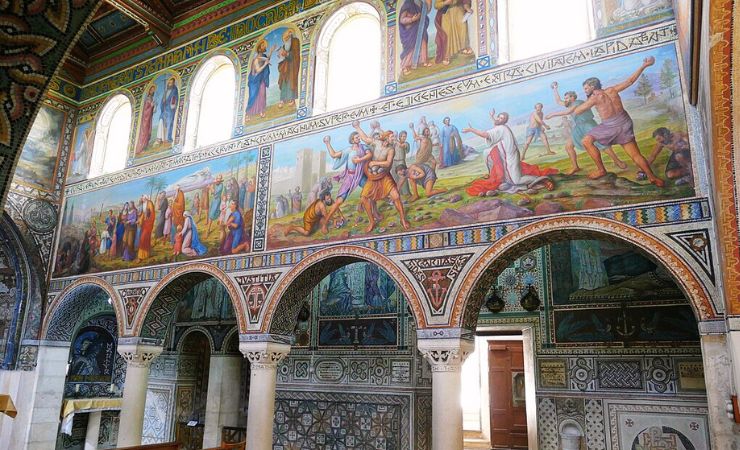Beit Jamal Monastery: From St. Stephen to Rabbi Gamaliel
Beit Jamal Monastery is a peaceful retreat located in serene natural surroundings that has a deep connection to St. Stephen, the first Christian martyr. St. Stephen, whose remains were traditionally believed to have been discovered here.
Location
Beit Jamal Monastery is situated approximately 30 kilometers west of Jerusalem, near the town of Beit Shemesh.



Beit Jamal's History
Beit Jamal Monastery has a long and varied history, dating back to the Byzantine period. The site was originally established as a monastic community in the 5th century by St. Hilarion, a disciple of St. Anthony the Great. Over the centuries, the monastery experienced periods of abandonment and revival, reflecting the turbulent history of the region.
In 1878, the Salesian Order, a Catholic religious institute founded by St. John Bosco, acquired the land and established an agricultural school. During excavations in 1915, the remains of a Byzantine church were uncovered, including a mosaic floor with a Greek inscription reading “The Most famous and holy God, Stephanus.” This discovery led to the identification of the site as the original burial place of St. Stephen.
Connection to St. Stephen and Rabbi Gamaliel
The association of Beit Jamal Monastery with St. Stephen, the first Christian martyr, dates back to the early Byzantine period. According to tradition, the remains of St. Stephen were discovered in 415 CE by a priest named Lucian, following a revelation in a dream. These relics were initially interred in a nearby cave before being moved to a church in Jerusalem.
Rabbi Gamaliel the Elder, a significant figure in Jewish history, is also connected to this site. According to Christian tradition, Gamaliel, a leading authority in the Sanhedrin and the teacher of Paul the Apostle, was buried here along with St. Stephen. The site of Beit Jamal was known as Kfar Gamala, named after Gamaliel. Excavations have revealed inscriptions and artifacts that support this connection, including a stone lintel with the inscription “DIAKONIKON STEPHANOU PROTOMARTYROS,” indicating the presence of St. Stephen’s relics.
In the New Testament, Paul refers to his education under Gamaliel in Acts 22:3, which reads: “I am a Jew, born in Tarsus of Cilicia, but brought up in this city. I studied under Gamaliel and was thoroughly trained in the law of our ancestors. I was just as zealous for God as any of you are today.” This connection is significant as it highlights the influence of Gamaliel on Paul, a key figure in early Christianity.
What Can Be Found at the Site
Visitors to Beit Jamal Monastery can explore a variety of features and attractions:
- Church of St. Stephen: Built in 1930 over the ruins of a 5th-century Byzantine church, it is adorned with stunning mosaics and frescoes depicting scenes from the life of St. Stephen. The church was designed by the Swiss architect Maurizio Gisler, a Benedictine monk from the Dormition Abbey in Jerusalem.
- Byzantine Tombs: Ancient tombs dating back to the Byzantine era, including a tomb believed to belong to St. Stephen. Excavations in the area have uncovered inscriptions indicating the presence of St. Stephen’s relics.
- Peaceful Gardens: Lush, well-maintained gardens offer a serene environment for meditation and relaxation. The gardens are filled with olive trees and various plants, contributing to the tranquil atmosphere of the monastery.
- Salesian Winery: A historic winery operated by the monks, where visitors can taste and purchase local wines. The monastery produces and markets its own honey, olive oil, and wine.
- Concerts and Pottery: The monastery holds concerts on some weekends in a small concert hall. Additionally, the nuns make and sell beautiful handmade pottery, adding to the cultural richness of the site.
Nearby Sites
- Tel Beit Shemesh: An ancient archaeological site revealing layers of history from the Canaanite, Israelite, and Philistine periods.
- Sorek Cave: Also known as Avshalom Cave, this stunning cave features a remarkable array of stalactites and stalagmites
- Mini Israel: A miniature park showcasing detailed replicas of over 350 famous Israeli landmarks, offering a unique perspective on the country’s diverse heritage.
- Latrun Monastery: Another picturesque monastery with a rich history, located a short drive from Beit Jamal, known for its tranquil atmosphere and beautiful gardens.





